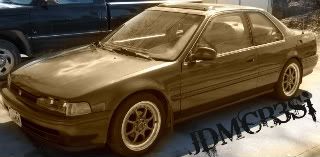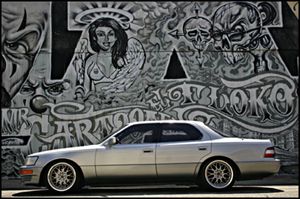 OK, so i just thought i might share some insight on prepping your car for a good paint job- from some of these recent threads i thought it might make for a helpful sticky or something-
OK, so i just thought i might share some insight on prepping your car for a good paint job- from some of these recent threads i thought it might make for a helpful sticky or something- I'm having trouble trying to find the roll of film with the right pics on it - so written instructions are all i can go with...
I'd say go for PPG paint - my experience, its really the best, and if that means you have to search out a PPG dealer, then by all means go for it - if we could find one in the middle of nowhere-north-central Louisiana, then it shouldn't be too hard for you
Make sure you know the type of gun you're using, it's probably HVLP (Hi Volume Lo Pressure) and ours is gravity fed (cups on top, allowing for more consistent, even spray)...
***STEP ONE***Sanding and Body Filling-take care of this ish before you go to the paint booth
- scuff sand the car all over to create a better surface for sealing - you DO NOT need to sand off all the paint, just rough it up
- any areas that require filler (small dings, rust spots, etc) should be COMPLETELY sanded down so that you are applying the bondo directly to the bare metal - deep rust will need to be cut out with new pieces welded in; and large dents will need to be pulled or replaced-fill in your low spots with bondo, working efficiently and carefully so that everything is as even and smooth as possible (i can give you more bondo tips later if you need)... you can test the smoothness by eying it or rubbing your finger accross once it is all dried
***STEP TWO***The Epoxy Primer-Sealer
Before you start:
**wear sleeves, long legs, eye protection, and get a good respirator, or, at the very least, the appropriate face mask- because those fumes WILL mess you up - a pack of cheap latex disposable gloves will do fine for the job
**we also normally lay plastic dropcloth on the booth/garage floor under the car before we start as well as all around the sides
and NOW....**remove your head and taillight assemblies, put them somewhere moisture-free - we also take the side view mirrors off, but you could just cover them up if you'd prefer
**cover up your exhaust, especially if it's aftermarket - the last thing you want is to be is removing paint from that beautiful chrome cause it's a bITCH
**with painter's tape (scotch brand 1 - 1/4" blue tape works best, imo) and craft paper, cover up your windows and anything else you don't want to paint
- your paint store should have rolls of this readily availible for pretty cheap
**apply the primer-sealer - we used MP170, a gray, non-chrome sealer that mixes at a 2:1 ratio with its catalyst, MP175
- keep an even distance ( about 6-10" away) and apply the primer smoothly and steadily
- get a nice even coat on there, about 1mm, don't over spray because you'll get runs and drips with a possible orange peel issue as your end result
- just keep this in mind: the primer-sealer is a layer that you DO NOT sand, so it is important to take as much care with it as you can
**dry time 30min @ 70F air temp (that's a rough estimate)... and take the time to let it dry properly; iknow that might seem like common sense but im just trying to get as much as i can covered for you
- it may take a little longer if the air is not dry enough and your booth is not temperature controlled (colder = longer) and too much humidity will equal a crappy job
***STEP THREE***Primer Surfacer**we used PPG MP181 1K Primer-Surfacer which mixes at a 1:1 ratio with MR Reducer
**Paint this on just as you did the last one and allow fair time to dry
**Wet sand as well as you can - smooth that car to where it almost feels as slick as bare metal (there may be some spots wher your sanding reveals the lighter gray sealer underneath... thats OK : )
**sand and prime sand and prime until everything is perfect then prime it one last time
***STEP FOUR*** put your car back together
***STEP FIVE*** take her to the paint shop(or move on to painting it yourself. and save the putting together for later)
Looking at receipts, prep materials alone (primer and catalyst/reducer, sandpaper, craft paper, tape ...etc) ran us about $200 after tax
if you do decide to do your own paint, be wary that factory colors are expensive -- our basecoat + clear and whatnot was a little more than $300... but red is also an expensive color -- there are other brands you can use, too, so do your research and find what you thing will work best
p.s. you can NEVER have too much sandpaper -- for the initial strip-down we use an orbital sander(and also a LOT of elbow grease and hand sanding)
just remember, the only layer of paint that SEALS your car is the clear coat - all primers and multi-stage coats are porous and suceptible to rapid wear/ pitting/fading etc... if you don't finish the job in a fair amount of time
and the prep work is 90% of a good looking finished product... it doesn't matter how nice your base and clear are- it's wasted if you don't take your time on the first steps
...yeah that was a mouthful but i hope it was a helpful one and any additions/questions/comments would be great





 **
**



Comment